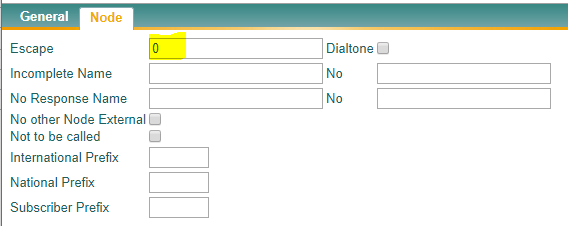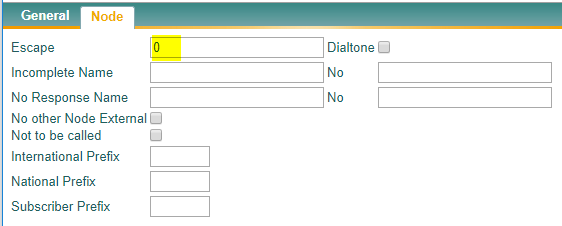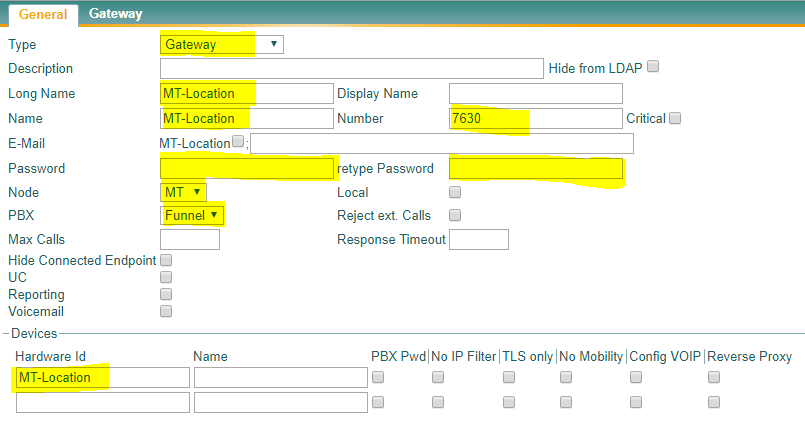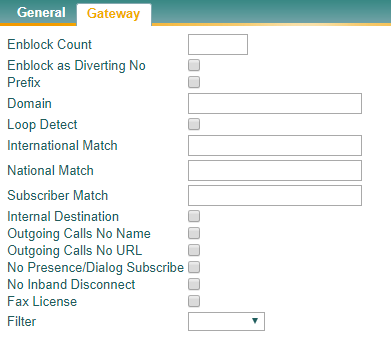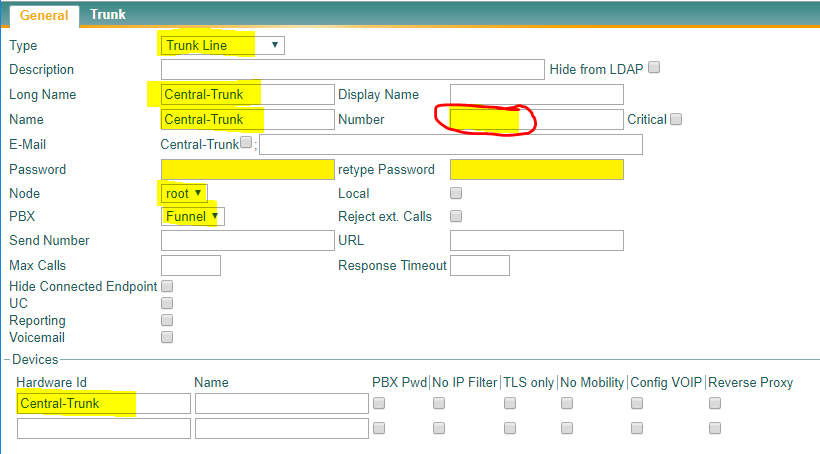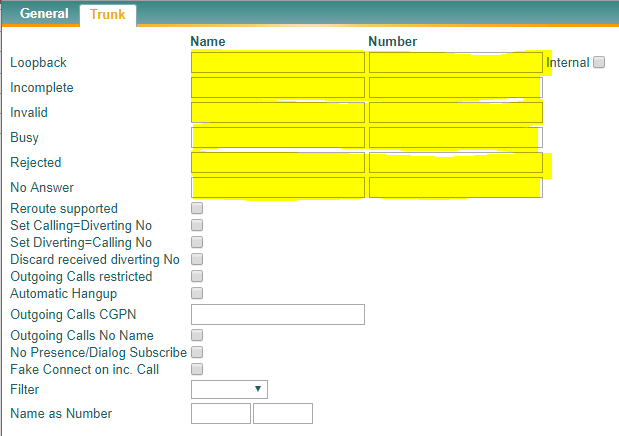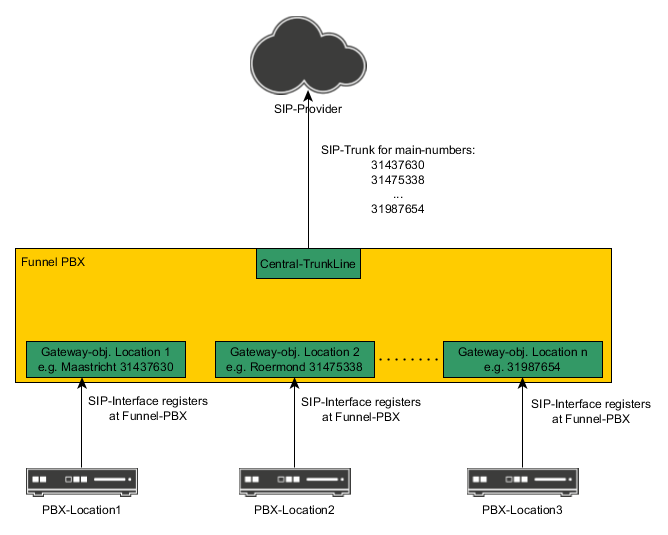Howto12r2:Central SIP trunk with multiple subscriber numbers: Difference between revisions
No edit summary |
No edit summary |
||
| Line 15: | Line 15: | ||
===More information=== | ===More information=== | ||
The simple solution of mapping internal CGPNs to external subscriber numbers doesn't work for redirected external call and additionally doesn't scale well. Therefore we use a different concept, where each customer subscriber number/location has its own TrunkLine. Registered to each TrunkLine-object is a SIP-interface, in the routing-table we set the UUI info to the correct subscriber number. The SIP-interface doesn't register directly at the SIP-provider but to a innovaphone PBX (we call it from now on "Funnel-PBX"), through it the call is routed to the central SIP-trunk. The Funnel-PBX has a node tree with appropriate placed Gateways for each customer location and a central breakout object for calls to the PSTN. | The simple solution of mapping internal CGPNs to external subscriber numbers doesn't work for redirected external call and additionally doesn't scale well. Therefore we use a different concept, where each customer subscriber number/location has its own TrunkLine. Registered to each TrunkLine-object is a SIP-interface, in the routing-table we set the UUI info to the correct subscriber number. The SIP-interface doesn't register directly at the SIP-provider but to a innovaphone PBX (we call it from now on "Funnel-PBX"), through it the call is routed to the central SIP-trunk. The Funnel-PBX has a node tree with appropriate placed Gateways for each customer location and a central breakout object for calls to the PSTN. The Funnel-PBX is independent of the customers other PBXs, i.e. a master PBX with own objects or a slave PBX with "license only" and no PBX-object replication. | ||
It is important to know that this concept comes with some limitations: | It is important to know that this concept comes with some limitations: | ||
* the provider must use the Identity-Header (P-Preffered-ID or P-Asserted-ID) for the evaluation of the correct subscriber number | * the provider must use the Identity-Header (P-Preffered-ID or P-Asserted-ID) for the evaluation of the correct subscriber number | ||
* each subscriber number must have an own TrunkLine object an a SIP-Interface registered to it, in order to set the correct UUI. To have in the customer PBX (not the Funnel-PBX) only one TrunkLine for all users will not work, see explanation above about CLIR and CLNS | * each subscriber number must have an own TrunkLine object an a SIP-Interface registered to it, in order to set the correct UUI. To have in the customer PBX (not the Funnel-PBX) only one TrunkLine for all users will not work, see explanation above about CLIR and CLNS | ||
* if the customer PBX uses a flat numbering plan(e.g. all users over all locations are in the root node), you need to use the physical location in order to choose the correct trunk-line object. | * if the customer PBX uses a flat numbering plan(e.g. all users over all locations are in the root node), you need to use the physical location in order to choose the correct trunk-line object. | ||
===Configuration of the Funnel PBX=== | ===Configuration of the Funnel PBX=== | ||
The Funnel-PBX must have an E164 numbering plan, in order to ensure that all numbers(cgpn and cdpn) sent to the central trunk have the same number format. The TrunkLine object for the central SIP-Trunk must be in the root node. Incoming and outgoing calls use therefore an "international" number format, as seen from the root node(e.g. 31437630 for a Location in NL, Maastricht). The Central-Trunk object must have no number, calls to this object are routed through the ''Route Root-Node External Calls to'' propriety of the Funnel-PBX. | |||
Start with | Start with configuring your Funnel PBX with the following Objects: | ||
* Node Objects with the Country Code, in this example the Node Objects for NL (Netherlands) with country code 31 | * Node Objects with the Country Code, in this example the Node Objects for NL (Netherlands) with country code 31 and country-specific escape(in most cases ''0'') | ||
* Node Objects with the location and prefix of the location, in this example the Node Objects for the locations Roermond (RM) and Maastricht (MT). | * Node Objects with the location and prefix of the location, in this example the Node Objects for the locations Roermond (RM) and Maastricht (MT). Again for each node configure an escape, e.g. 0 | ||
* Gateway Objects with the | * Gateway Objects with the number matching the PSTN main number of the customer PBX-locations. | ||
* | * Trunk Line Object in the Funnel-PBX, having as node attribute ''root'' and no number. Here the main SIP-trunk to provider will register. | ||
'''Although that in some examples the password field is left blank, you should consider security and configure safe passwords for all objects !''' | |||
'''Although that in some examples the password field is left blank, you should consider security and | |||
| Line 84: | Line 75: | ||
===Configuration of a location PBX-Gateway=== | ===Configuration of a location PBX-Gateway=== | ||
The PBX in the locations can be a Single Master PBX, a slave PBX or slave PBX that is part of an e164 | The PBX in the locations can be a Single Master PBX, a slave PBX or slave PBX that is part of an e164 PBX configuration. | ||
'''The type of PBX doesn't matter for the registration to the Funnel-PBX.''' | '''The type of PBX doesn't matter for the registration to the Funnel-PBX.''' | ||
| Line 90: | Line 81: | ||
The registration to the Funnel PBX is done via a SIP trunk registration to the Gateway Object in the Funnel-PBX. | The registration to the Funnel PBX is done via a SIP trunk registration to the Gateway Object in the Funnel-PBX. | ||
The Configuration of the SIP trunk is | The Configuration of the SIP trunk is done using a SIP-profile. | ||
<!-- | |||
[[Image:MT-Location SIP Trunk Configuration.PNG]] | [[Image:MT-Location SIP Trunk Configuration.PNG]] | ||
| Line 107: | Line 99: | ||
In the Maastricht location we use as single MSN number 31 43 7777 579. Because this number is not part of the DID range 7630 xxx, we have to create a single number map to the desired destination, preferable a number in the original DID range. | In the Maastricht location we use as single MSN number 31 43 7777 579. Because this number is not part of the DID range 7630 xxx, we have to create a single number map to the desired destination, preferable a number in the original DID range. | ||
--> | |||
=== | ====Special case: MSNs==== | ||
The config above works for DDI-capable SIP-trunks. If a location uses MSNs, then the Funnel-PBX config and the SIP-Trunk config on the location-PBX must be adjusted. For incoming calls (PSTN->PBX), the Funnel-PBX must route calls for MSNs to the corresponding Gateway-object. This is done using NumberMaps, pointing to the number of the corresponding Gateway-object. If the location has only MSNs(no DDI capable trunk), you need to assign the gateway-object a "fictive" Number(e.g. ''#100''), in order to route calls to extensions in the location (e.g. MSN 871234 should be routed to internal extension 212, so the numbermaps destination is #100212). For outbound call, the internal extension is mapped to the corresponding MSN in the routing table of the local-pbx. You use the CGPN-maps for this (e.g. 212 -> 871234). | |||
For the Funnel-PBX you | |||
===Summary=== | |||
The following diagram shows a simple scenario of a Funnel PBX with N locations providing a central big sip trunk for all sub-locations. | |||
The sub-locations providing PBX functionality for the location. (and can also provide the gateway-functionality to a legacy PBX for a migrations scenario). | |||
[[Image:Simple scenario Funnel PBX.png]] | |||
===Licenses=== | ===Licenses=== | ||
| Line 121: | Line 119: | ||
'''Funnel-PBX.''' | '''Funnel-PBX.''' | ||
In the Funnel_PBX you need only Port-licenses | In the Funnel_PBX you need only Port-licenses. You need 1 Port lic. for the internal registration of the Central-Trunk to your SIP Provider. | ||
Further you need 1 Port lic. for every sub-location that registers on the Gateway Object of | Further you need 1 Port lic. for every sub-location that registers on the Gateway Object of its PBX Location. | ||
'''For example:''' | '''For example:''' | ||
| Line 154: | Line 136: | ||
Total amount of Port lic in the Funnel-PBX = 67 Port lic. | Total amount of Port lic in the Funnel-PBX = 67 Port lic. | ||
<!-- == Related Articles == --> | <!-- == Related Articles == --> | ||
[[Category:Howto|{{PAGENAME}}]] | [[Category:Howto|{{PAGENAME}}]] | ||
Revision as of 17:32, 15 December 2017
Applies To
This information applies to
V12r2 sr6 Build 12.5236 and later.
This document is still under construction! --Kpe 20:21, 21 November 2017 (CET)
Overview
Currently SIP-Providers are offering customers the centralisation of their multiple SIP-trunks on one SIP-trunk. This means that one central SIP-Trunk is assigned with more then one subscriber numbers, often also from different area codes. The provider expects that the innovaphone gateway sends the correct/matching subscriber number, so that the provider can relate the calls to the correct subscriber number. This should be still possible if the caller hides his own number(CLIR) or in case of redirected external calls using Clip No screening(CLNS).
More information
The simple solution of mapping internal CGPNs to external subscriber numbers doesn't work for redirected external call and additionally doesn't scale well. Therefore we use a different concept, where each customer subscriber number/location has its own TrunkLine. Registered to each TrunkLine-object is a SIP-interface, in the routing-table we set the UUI info to the correct subscriber number. The SIP-interface doesn't register directly at the SIP-provider but to a innovaphone PBX (we call it from now on "Funnel-PBX"), through it the call is routed to the central SIP-trunk. The Funnel-PBX has a node tree with appropriate placed Gateways for each customer location and a central breakout object for calls to the PSTN. The Funnel-PBX is independent of the customers other PBXs, i.e. a master PBX with own objects or a slave PBX with "license only" and no PBX-object replication.
It is important to know that this concept comes with some limitations:
- the provider must use the Identity-Header (P-Preffered-ID or P-Asserted-ID) for the evaluation of the correct subscriber number
- each subscriber number must have an own TrunkLine object an a SIP-Interface registered to it, in order to set the correct UUI. To have in the customer PBX (not the Funnel-PBX) only one TrunkLine for all users will not work, see explanation above about CLIR and CLNS
- if the customer PBX uses a flat numbering plan(e.g. all users over all locations are in the root node), you need to use the physical location in order to choose the correct trunk-line object.
Configuration of the Funnel PBX
The Funnel-PBX must have an E164 numbering plan, in order to ensure that all numbers(cgpn and cdpn) sent to the central trunk have the same number format. The TrunkLine object for the central SIP-Trunk must be in the root node. Incoming and outgoing calls use therefore an "international" number format, as seen from the root node(e.g. 31437630 for a Location in NL, Maastricht). The Central-Trunk object must have no number, calls to this object are routed through the Route Root-Node External Calls to propriety of the Funnel-PBX.
Start with configuring your Funnel PBX with the following Objects:
- Node Objects with the Country Code, in this example the Node Objects for NL (Netherlands) with country code 31 and country-specific escape(in most cases 0)
- Node Objects with the location and prefix of the location, in this example the Node Objects for the locations Roermond (RM) and Maastricht (MT). Again for each node configure an escape, e.g. 0
- Gateway Objects with the number matching the PSTN main number of the customer PBX-locations.
- Trunk Line Object in the Funnel-PBX, having as node attribute root and no number. Here the main SIP-trunk to provider will register.
Although that in some examples the password field is left blank, you should consider security and configure safe passwords for all objects !
Funnel-PBX Objects
Create the Funnel PBX Objects like in this example NL with country code 31
Node Object General
Create the Node Object with the country code
Node Object General
Create the Node Object for the locations like in this example MT with area code 43
Gateway Object General
Create the Gateway Object for the PBX/Gateway in the location. In this example with PBX prefix 7630.
Repeat these steps for all the locations in your scenario.
Trunk Line Object
Create a Trunk Line Object Central-Trunk. The number field in the Trunk Line Object is left blank by purpose. The reason is to avoid this number to be displayed in your telephone set after the connection has been established (Connected Number).
Choose some reasonable destinations for Loopback, Incomplete, Invalid, Busy, Rejected and No Answer. For example the Operators destination number in the HeadOffice.
Configuration of a location PBX-Gateway
The PBX in the locations can be a Single Master PBX, a slave PBX or slave PBX that is part of an e164 PBX configuration.
The type of PBX doesn't matter for the registration to the Funnel-PBX.
The registration to the Funnel PBX is done via a SIP trunk registration to the Gateway Object in the Funnel-PBX.
The Configuration of the SIP trunk is done using a SIP-profile.
Special case: MSNs
The config above works for DDI-capable SIP-trunks. If a location uses MSNs, then the Funnel-PBX config and the SIP-Trunk config on the location-PBX must be adjusted. For incoming calls (PSTN->PBX), the Funnel-PBX must route calls for MSNs to the corresponding Gateway-object. This is done using NumberMaps, pointing to the number of the corresponding Gateway-object. If the location has only MSNs(no DDI capable trunk), you need to assign the gateway-object a "fictive" Number(e.g. #100), in order to route calls to extensions in the location (e.g. MSN 871234 should be routed to internal extension 212, so the numbermaps destination is #100212). For outbound call, the internal extension is mapped to the corresponding MSN in the routing table of the local-pbx. You use the CGPN-maps for this (e.g. 212 -> 871234).
Summary
The following diagram shows a simple scenario of a Funnel PBX with N locations providing a central big sip trunk for all sub-locations.
The sub-locations providing PBX functionality for the location. (and can also provide the gateway-functionality to a legacy PBX for a migrations scenario).
Licenses
What kind of licenses do you need and how many ?
Funnel-PBX.
In the Funnel_PBX you need only Port-licenses. You need 1 Port lic. for the internal registration of the Central-Trunk to your SIP Provider. Further you need 1 Port lic. for every sub-location that registers on the Gateway Object of its PBX Location.
For example:
You have 65 Sub-locations (with a Legacy-PBX) and 1 Headquarter (with a Legacy-PBX).
IPVA Funnel-PBX:
1 Port lic. Central-Trunk to SIP provider
1 Port lic. per location for (Registered Gateway Object)
N locations = 66 (HQ + 65 sub-locations)
Total amount of Port lic in the Funnel-PBX = 67 Port lic.


